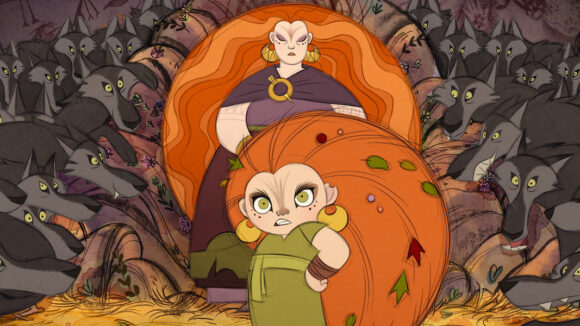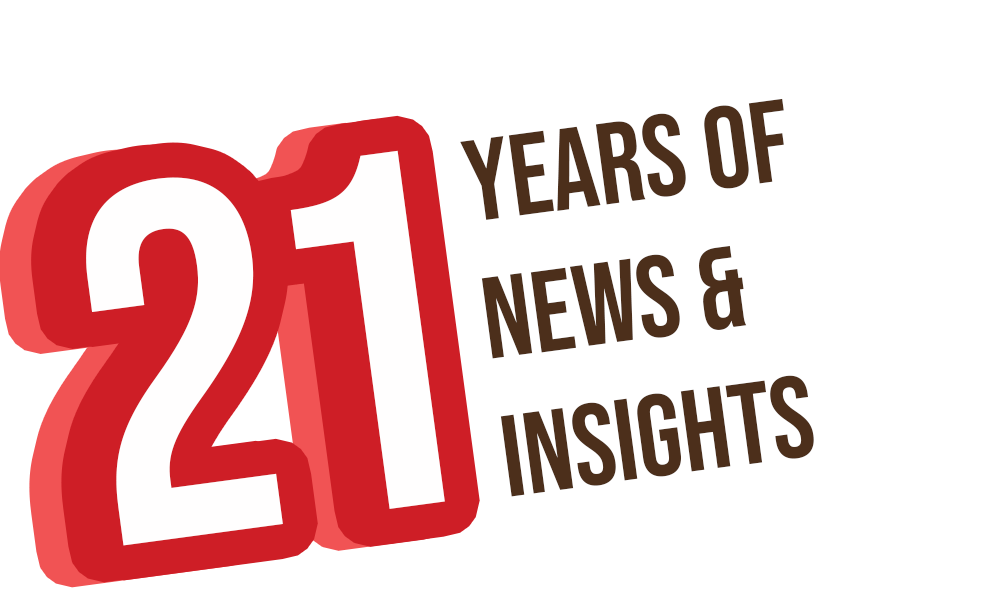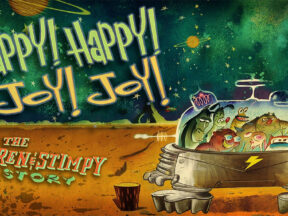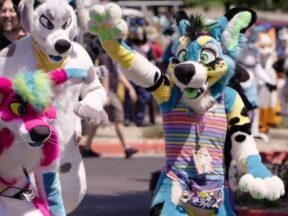

‘Wolfwalkers’ Review: Cartoon Saloon Hits New Artistic Heights In Return To Irish Folklore
And there you have it: Apple, the third-largest company in the world, has an animated feature to its name. Cartoon Saloon was a canny choice of partner in this venture. The Irish studio’s first three features, beguiling stories of adventuring children, were told with enough imagination and visual flair to draw a fan following (and an Oscar nomination each). Its films are humane, enchanting, and fun — qualities Apple could do with as it reinvents itself as an entertainment brand.
Wolfwalkers will please the faithful, as it follows in the lineage of the studio’s features The Secret of Kells (2009) and Song of the Sea (2014). Tomm Moore, who directed those films and co-directs this one with erstwhile art director Ross Stewart, has said as much: he calls this the “final panel of our Irish folklore triptych.” The difference here is that, with time (and a visibly bigger budget), the studio has reached new levels of artistry.
Like Kells in particular, Wolfwalkers deftly reimagines fragments of Irish mythology while grounding them in history. It’s the mid-17th century, and Oliver Cromwell’s Puritan army has invaded from England and set up camp in Kilkenny (the city, incidentally, where Cartoon Saloon is based). As part of his plan of conquest and deforestation, Cromwell has set a bounty on the local wolves, attracting professional hunters from England — including Bill Goodfellowe, who lives in Kilkenny with his young daughter Robyn.
Escaping to the woods, Robyn encounters a feral cave-dwelling girl named Mebh, whose shape-shifting powers cue the film’s shift into fable. In a spin on the old legend of the werewolves of Ossory, Mebh is revealed to be a Wolfwalker — she assumes the form of a wolf when asleep, thus embodying the essential bond between humans and nature. The scene is set for a clash between the army and forest folk, and between two outlooks on nature: as something to cherish or as something to tame.
The production design revels in this opposition. The austere grey-brown palettes and angular woodcut lines of the city give way to autumnal hues, painterly textures, curved forms, and sketchy linework in the forest. This approach extends to the characters. Robyn has the pointed features of a young Saoirse Ronan, and the spiky-faced urchins of Kilkenny could be in a Jamie Hewlett comic; meanwhile, Mebh shares the round, organic shape of the cave she lives in.

The film’s world is revealed in daring layouts — a hallmark of the studio’s films — that deploy non-linear perspective to striking effect. Thus, from the forest’s fringes, the distant town of Kilkenny appears to loom ominously out of the sky. The film is relentlessly inventive with composition. Case in point: a shot in which Cromwell looks through the visor of his helmet, which cuts up the frame like crosshairs while also evoking the crucifix (the symbol at the heart of his crusade).
Cromwell is one of the great villains of Irish history, and it’s understandable that he’s presented here as a bloodthirsty despot. But his characterization sets the tone for the story, in which the contrast between city and nature is sometimes overplayed. Pitted against Cromwell’s tyrannical forces, the wolves are cuddly innocents, their woods a bucolic wonderland. This portrait doesn’t entirely do justice to the beauty of nature, which is rooted also in awe, even fear.
The boundary between good and evil is drawn as thickly as Kilkenny’s woodcut outlines. The most ambiguous character is Bill Goodfellowe, who’s at once a hunter for Cromwell and a loving father to Robyn. Yet, almost from the start, he performs his duties to Cromwell with sad resignation, leaving us in little doubt about his eventual redemption. Compare with the nuanced characters that populate the eco-epics of Hayao Miyazaki, one of Cartoon Saloon’s creative lodestars: they often act unpredictably, their motives not immediately clear.

Will Collins’s polished script keeps the plot moving fast, as war clouds gather and Robyn’s loyalties are torn between father and forest. The Wolfwalkers’ magic powers become increasingly central to things, in ways that feel exhilarating at times and arbitrary at others. In a bold stylistic device, we’re shown the wolves’ perspective as they run through their environments, which are rendered in expressionistic streaks. Coming amid the film’s stylized flatness, these 3d-assisted scenes, created with Irish animator Eimhin McNamara, startle us with their sudden movement into depth.
And then, at moments, the grand canvas of history recedes, the action lets up, and the film lingers on a tender exchange between Robyn and Mebh. The girls have pain in common: they have both lost one parent and watched the other suffer indignities. Yet their friendship is forged through shared joys, as they play with each other’s hair or gambol in the forest at night. These scenes are beautifully observed; for all the film’s high drama and fantastical set-pieces, they are what will stay with me.
“Wolfwalkers” premiered last week at the Toronto International Film Festival. It will be released on Apple TV+ later this year, after a theatrical run.
Directors: Tomm Moore, Ross Stewart
Writer: Will Collins
Producers: Paul Young, Nora Twomey, Tomm Moore, Stéphan Roelants
Production studios: Cartoon Saloon, Melusine Productions
Cast: Honor Kneafsey, Eva Whittaker, Sean Bean, Simon McBurney, Tommy Tiernan, Jon Kenny, John Morton, Maria Doyle Kennedy

.png)

